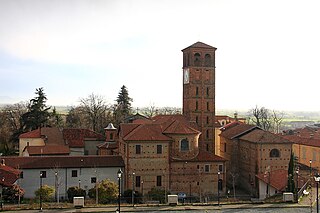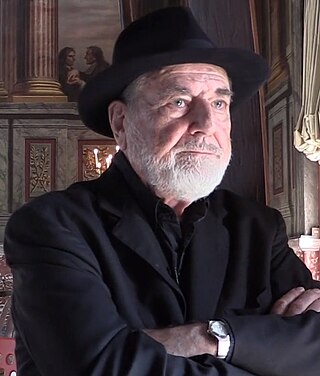
Ugo Nespolo is an Italian artist, painter, sculptor, filmmaker and writer. He lives and works in Turin.
Oton Gliha was a Croatian artist, born in Slovenia. A graduate of the Academy of fine Arts in Zagreb, Gliha continued his studies in Paris, Vienna and Munich. He is best known for his series of abstract paintings based on the patterns of the drystone walls of coastal Croatia. The first in the series appeared in 1954, and it was a theme he developed for the rest of his life.

Arman was a French-born American artist. Born Armand Fernandez in Nice, France, Arman was a painter who moved from using objects for the ink or paint traces they leave to using them as the artworks themselves. He is best known for his Accumulations and destruction/recomposition of objects.
Mohsen Vaziri Moghaddam, was an Iranian-born painter, sculptor, and a professor of art. He was most notable for his style of abstract expressionism, and was once referred to as the "pioneer of modern Iranian abstraction".

Mario Merz was an Italian artist, and husband of Marisa Merz.

Domenico "Mimmo" Rotella was an Italian artist considered an important figure in post-war European art. Best known for his works of décollage and psychogeographics, made from torn advertising posters. He was associated to the Ultra-Lettrists an offshoot of Lettrism and later was a member of the Nouveau Réalisme, founded in 1960 by the art critic Pierre Restany.
Johnny Friedlaender was a leading German/French 20th-century artist, whose works have been exhibited in Germany, France, Netherlands, Italy, Japan and the United States. He has been influential upon other notable artists, who were students in his Paris gallery. Johnny painted using oils and watercolors but his preferred medium was aquatint etching which is a technically difficult artistic process, of which Friedlaender has been a pioneer.

Paul Durand-Ruel was a French art dealer associated with the Impressionists and the Barbizon School. Being the first to support artists such as Claude Monet, Camille Pissarro, and Pierre-Auguste Renoir, he is known for his innovations in modernizing art markets, and is generally considered to be the most important art dealer of the 19th century. An ambitious entrepreneur, Durand-Ruel cultivated international interest in French artists by establishing art galleries and exhibitions in London, New York, Berlin, Brussels, among other places. Additionally, he played a role in the decentralization of art markets in France, which prior to the mid-19th century was monopolized by the Salon system.

Caluso is a comune (municipality) in the Metropolitan City of Turin in the Italian region Piedmont, located about 30 kilometres (19 mi) northeast of Turin.

Alighiero Fabrizio Boetti, known as Alighiero e Boetti was an Italian conceptual artist, considered to be a member of the art movement Arte Povera.

Antonio Fontanesi was an Italian painter who lived in Meiji period Japan between 1876 and 1878. He introduced European oil painting techniques to Japan, and exerted a significant role in the development of modern Japanese yōga painting. He is known for his works in the romantic style of the French Barbizon school.

Juan T. Vázquez Martín lived and worked in Havana, died in Miami. This artist is listed among the Cuban Painters masters. An exceptional prolific abstract painter with a refine style of paint, creativity and cultivated technique. Painter, founder and director of art schools and galleries, teacher of drawing and painting, he was an artist who travelled the world for solo exhibitions, or as a curator for Cuban painters art shows. His paintings are held in international and private collections in South and Central America and Caribbean islands, North America, Europe, Asia, Africa and Middle East.

Michelangelo Pistoletto is an Italian painter, action and object artist, and art theorist. Pistoletto is acknowledged as one of the main representatives of the Italian Arte Povera. His work mainly deals with the subject matter of reflection and the unification of art and everyday life in terms of a Gesamtkunstwerk.
Elizabeth H. Lidow was an American artist.
Amar Ben Belgacem was a French-born Tunisian self-taught painter.
Giulio Paolini is an Italian artist associated with both Arte Povera and Conceptual Art.
Piero Gilardi was a visual artist. Born in Italy from a Swiss family, he studied at the Liceo Artistico in Turin. In an interview with LeGrace G. Benson, Gilardi stated that his personal encounter with artist Michelangelo Pistoletto and others helped him in the development of his own artwork. While trying to comprehend the cybernetic idea of feedback and the scientific rationale behind man's mental synthesis, his perspective on reality changed; he then focused on the fluxus and relationship of things around him.

Francesco Bonami is an Italian art curator and writer who is currently Honorary Director of Fondazione Sandretto Re Rebaudengo in Turin. He lives in Milan and Manhattan, New York.

Park Eun Sun is a South Korean sculptor.
Shigeru Onishi (大西茂)(1928-1994) was a Japanese visual artist. Onishi produced photography-based work and abstract ink paintings. Michel Tapié introduced Onishi's calligraphic works to Europe with works by the Gutai group artists in the context of the Art Informel movement. These calligraphic works used the sumi method that Japanese painters traditionally use from ink made from soot or oil and animal glue.











